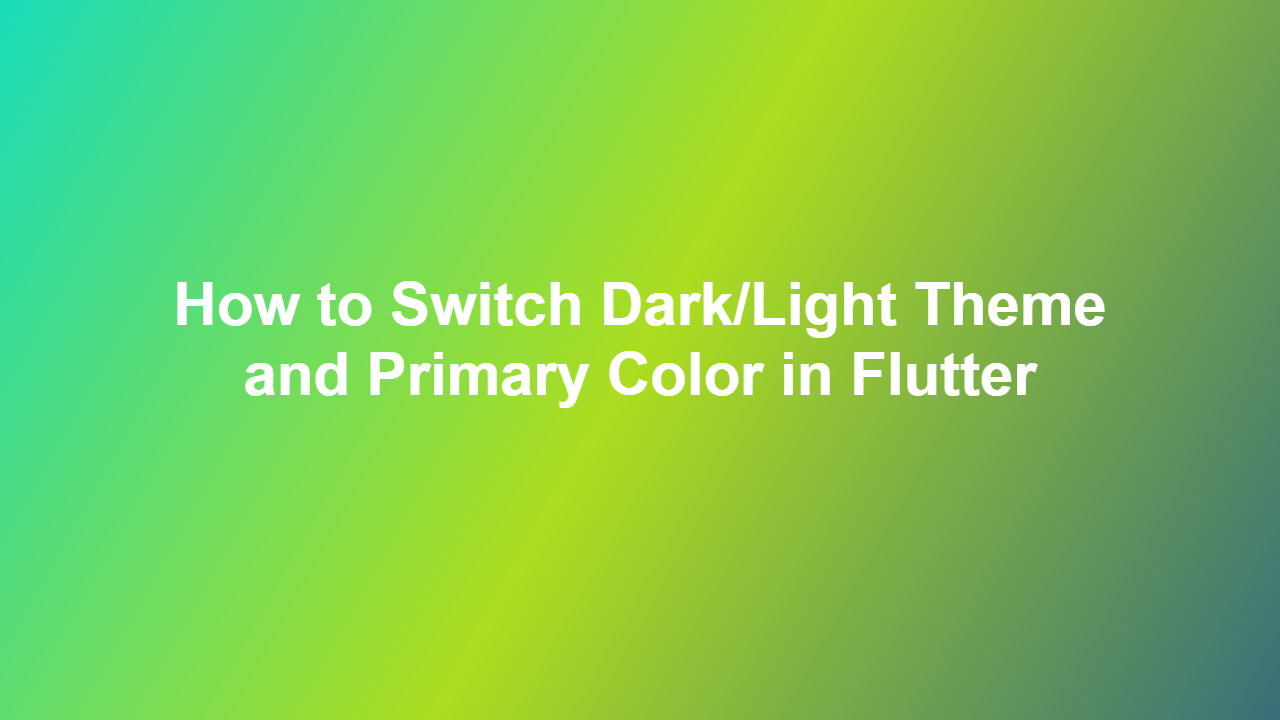How to Switch Dark/Light Theme and Primary Color in Flutter
Introduction
————
In mobile application development, theme switching is a feature that allows users to switch between dark and light modes. This feature is essential for providing a better user experience, especially for users who prefer to use their devices in low-light environments. In Flutter, theme switching can be easily achieved by using the `Theme` widget. In this article, we will explore how to switch between dark and light themes and primary colors in Flutter.
Switching Dark/Light Theme
To switch between dark and light themes in Flutter, you can use the `ThemeMode` enum. This enum has two values: `ThemeMode.light` and `ThemeMode.dark`. You can use the `Theme` widget to set the theme mode. Here is an example of how to switch between dark and light themes:
“`dart
import ‘package:flutter/material.dart’;
class MyApp extends StatefulWidget {
@override
MyAppState createState() => MyAppState();
}
class _MyAppState extends State
ThemeMode _themeMode = ThemeMode.light;
@override
Widget build(BuildContext context) {
return MaterialApp(
title: ‘Theme Switching’,
themeMode: _themeMode,
theme: ThemeData(
primarySwatch: Colors.blue,
),
darkTheme: ThemeData(
primarySwatch: Colors.blue,
brightness: Brightness.dark,
),
home: Scaffold(
body: Center(
child: ElevatedButton(
onPressed: () {
setState(() {
themeMode = themeMode == ThemeMode.light
? ThemeMode.dark
: ThemeMode.light;
});
},
child: Text(_themeMode == ThemeMode.light
? ‘Switch to Dark’
: ‘Switch to Light’),
),
),
),
);
}
}
“`
Switching Primary Color
To switch the primary color in Flutter, you can use the `ThemeData` class. This class has a property called `primarySwatch`, which is used to set the primary color. Here is an example of how to switch the primary color:
“`dart
import ‘package:flutter/material.dart’;
class MyApp extends StatefulWidget {
@override
MyAppState createState() => MyAppState();
}
class _MyAppState extends State
Color _primaryColor = Colors.blue;
@override
Widget build(BuildContext context) {
return MaterialApp(
title: ‘Primary Color Switching’,
theme: ThemeData(
primarySwatch: _primaryColor,
),
home: Scaffold(
body: Center(
child: ElevatedButton(
onPressed: () {
setState(() {
primaryColor = primaryColor == Colors.blue
? Colors.red
: Colors.blue;
});
},
child: Text(_primaryColor == Colors.blue
? ‘Switch to Red’
: ‘Switch to Blue’),
),
),
),
);
}
}
“`
Conclusion
———-
In this article, we have explored how to switch between dark and light themes and primary colors in Flutter. We have seen how to use the `Theme` widget to set the theme mode and how to use the `ThemeData` class to set the primary color. With this knowledge, you can create a flexible and user-friendly theme switching system for your Flutter application.
Frequently Asked Questions
—————————
1. Q: How do I switch between dark and light themes in Flutter?
A: You can switch between dark and light themes in Flutter by using the `ThemeMode` enum and the `Theme` widget.
2. Q: How do I set the primary color in Flutter?
A: You can set the primary color in Flutter by using the `ThemeData` class and the `primarySwatch` property.
3. Q: Can I use a custom color as the primary color?
A: Yes, you can use a custom color as the primary color by creating a custom `MaterialColor` object.
4. Q: How do I create a custom `MaterialColor` object?
A: You can create a custom `MaterialColor` object by using the `MaterialColor` constructor and passing in a map of color shades.
5. Q: Is theme switching important for user experience?
A: Yes, theme switching is important for user experience, especially for users who prefer to use their devices in low-light environments.
